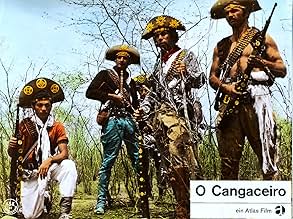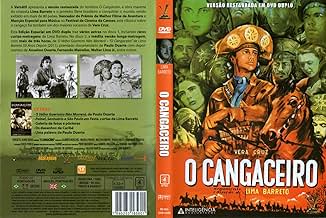Agrega una trama en tu idioma'Capitão', a bandit, terrorizes poor villages in the Northeast region of Brazil, looting and frequently killing with his armed gang, until he kidnaps and becomes attracted to a beautiful sch... Leer todo'Capitão', a bandit, terrorizes poor villages in the Northeast region of Brazil, looting and frequently killing with his armed gang, until he kidnaps and becomes attracted to a beautiful schoolteacher, creating discord in his group.'Capitão', a bandit, terrorizes poor villages in the Northeast region of Brazil, looting and frequently killing with his armed gang, until he kidnaps and becomes attracted to a beautiful schoolteacher, creating discord in his group.
- Dirección
- Guionistas
- Elenco
- Premios
- 2 premios ganados y 1 nominación en total
Opiniones destacadas
8driq
I saw this film at the Carnegie Cinema in NYC 50 years ago and still remember it. It was beautifully filmed. Aside from the plot, the background music, O Canganceiro which is played as an instrumental and choral is absolutely haunting. The female lead was exceptionally beautiful. As I recall, the film was a minor sensation at the time, but has since disappeared into the mists of history. Too bad. Is it available anywhere today?
(the 10 line minimum doesn't make sense. Why should I be forced to pad my comments when brevity is the soul of wit. This was a simple film,that doesn't require complex, "filomatic" critical comment!)
(the 10 line minimum doesn't make sense. Why should I be forced to pad my comments when brevity is the soul of wit. This was a simple film,that doesn't require complex, "filomatic" critical comment!)
10elmar5
I saw this movie as an adolescent in the 60es just once on TV, but it still is one of only a handful which surface at least once every five years. As other reviewers have pointed out before, the great music by Zé do Norte was a major factor for this memorability. Foremost here is the ballad "Mulher Rendeira" (The Lacemaker), especially in the unforgettable scene when the gang rides in a duck line along a ridge which is set against the dusk sky and the gloomy grandeur of the Brazilian Sertao. In their leather garments, pepped up by the symbolism of amulets and talismans, the bandidos in this movie resemble an archaic tribe living in this land of dust and thorns for eons already. The movie is filmed in black and white which is lending it a certain kind of credibility reminding of a documentary. Although presenting a different plot, Barreto's movie was obviously inspired by the fate of the most famous couple of Brazilian cangaceiros, Lampiao and his wife Maria Bonita, who were killed in 1938 with seven others of their gang by the police.
This film was the first brazilian production exhibited internationally after receive a prize of Best Music at a Cannes Film Festival. It was distributed accross the world by Columbia Pictures and was very successful at the box office.
I understand why foreign audiences still enjoy it, but for us brazilians it's very artificial when the hero leaves the semi arid background where the bandits live and penetrates a deep jungle to fight a jaguar etc, since those geographical regions are separated by hundred and hundred miles, like Arizona from Oregon. Anyway the music is amazing as the photography and the actor who plays captain Galdino ( Milton Ribeiro ). I believe that the main influence of director Lima Barreto was not the american westerns as most of people say, but the mexican films of Emilio Fernandez like "Enamorada". "O cangacero" is a good film, even if not not a great one and deserves the fame it has.
I understand why foreign audiences still enjoy it, but for us brazilians it's very artificial when the hero leaves the semi arid background where the bandits live and penetrates a deep jungle to fight a jaguar etc, since those geographical regions are separated by hundred and hundred miles, like Arizona from Oregon. Anyway the music is amazing as the photography and the actor who plays captain Galdino ( Milton Ribeiro ). I believe that the main influence of director Lima Barreto was not the american westerns as most of people say, but the mexican films of Emilio Fernandez like "Enamorada". "O cangacero" is a good film, even if not not a great one and deserves the fame it has.
Another great film that is characterised by a memorable music score. Not all films with great music are great films, but haunting or otherwise memorable scores are a feature of so many of the greatest films of all time - The Third Man, Jeux Interdits, High Noon, American Graffiti, most of the Kubrick opus, Who's Afraid of Virginia Woolf and probably any documentary adopting Philip Glass' minimalism (The Thin Blue Line and The Fog of War) being prominent examples. This is so even when the music is not original but simply selected and edited in from classical music, popular or folk songs, as appropriate and evocative. Bets are that you won't be able to get the title folk song of O Cangaceiro out of your head for some time after you've finished watching it - it seems to affect every viewer that way.
This is a film reminiscent of The Wages of Fear, in its portrayal of poverty and the brutality, especially towards women, traditionally endemic in South America. No wonder Claude Levi-Strauss entitled his seminal ethnographic work based on travels in South America "Tristes Tropiques".
I had been warned of the brutality of the horse-dragging scene in this film - yet I can only say that it pales into insignificance with the graphic closing horse-dragging scene of The Cowboys - when I guess John Wayne was, as his career closed, ever more drawn to reactionary law-and-order neanderthalism.
A melancholic film with great B/W cinematography and even better music, depicting that eternal South American atmosphere of brutality and tragic sadness. A rare film well worth watching.
This is a film reminiscent of The Wages of Fear, in its portrayal of poverty and the brutality, especially towards women, traditionally endemic in South America. No wonder Claude Levi-Strauss entitled his seminal ethnographic work based on travels in South America "Tristes Tropiques".
I had been warned of the brutality of the horse-dragging scene in this film - yet I can only say that it pales into insignificance with the graphic closing horse-dragging scene of The Cowboys - when I guess John Wayne was, as his career closed, ever more drawn to reactionary law-and-order neanderthalism.
A melancholic film with great B/W cinematography and even better music, depicting that eternal South American atmosphere of brutality and tragic sadness. A rare film well worth watching.
O Cangaceiro is a great film, with great artists and great songs. We can see a young Vanja Orico singing "Sodade Meu Bem Sodade", a composition by Zé do Norte, an extraordinary Brazilian composer. Now we can hear his songs through his son, the singer Toninho Di Lita, who makes another extraordinary performance, singing with his wife Inajara De Tanduí and his group Bando do Galo Doido, with great singers and musicians like Elísio Paschoal(Hermeto Pachoal's brother), Eliane Carneiro, Chaguinha Lima(Siri Atômico Band), Guto(Siri Atômico Band), Teresa Carvalho(Dama de Paus) and Will Tom(Dama de Paus), who sang with John Phillips in a Tour in Brazil. Toninho Di Lita is a great presence on theaters of Rio de Janeiro, singing songs made by his father and a lot of his own compositions. With new musical cloths Toninho Di Lita sings "Sodade Meu Bem Sodade", "Meu Pião", "Mulher Rendeira" and some hits of his own. "Manto Negro" is a beautiful composition who explains about the personality of the death. Toninho is always worried about education so he also makes performances to Universities and to Public Schools. More about him we can see on "www.orkut.com" - Toninho Di Lita. He is very nice with his fans.
¿Sabías que…?
- TriviaThe very first Brazilian film to compete at the Cannes Film Festival.
- ConexionesEdited into A Edição do Nordeste (2023)
Selecciones populares
Inicia sesión para calificar y agrega a la lista de videos para obtener recomendaciones personalizadas
Detalles
- Tiempo de ejecución1 hora 45 minutos
- Color
- Mezcla de sonido
- Relación de aspecto
- 1.37 : 1
Contribuir a esta página
Sugiere una edición o agrega el contenido que falta

Principales brechas de datos
By what name was O Cangaceiro (1953) officially released in India in English?
Responda




















